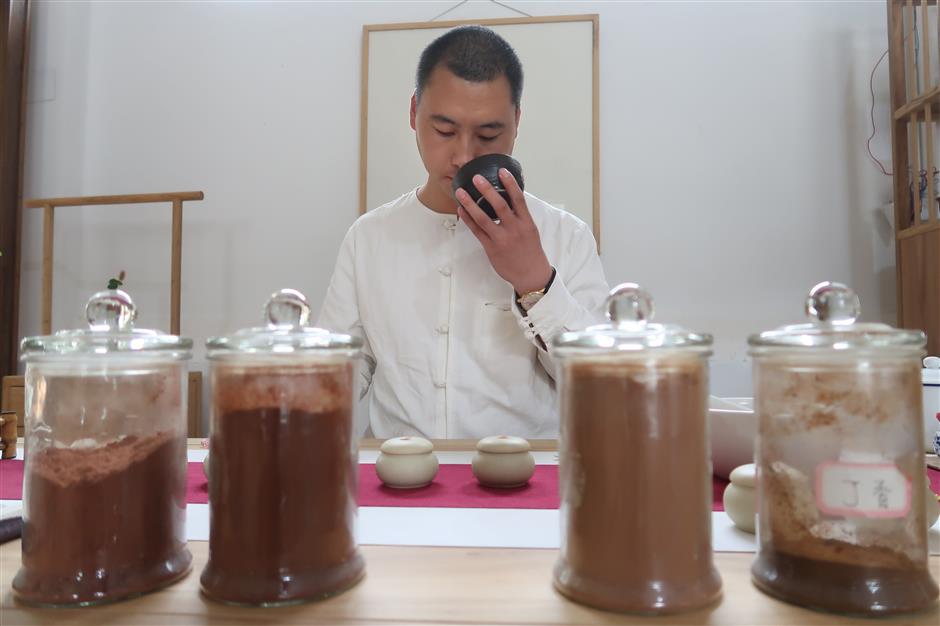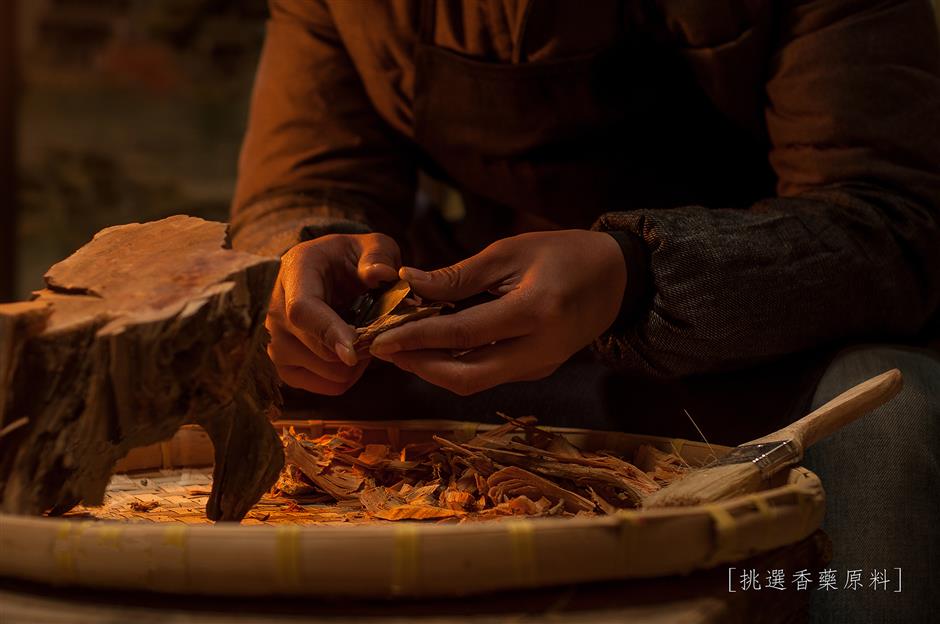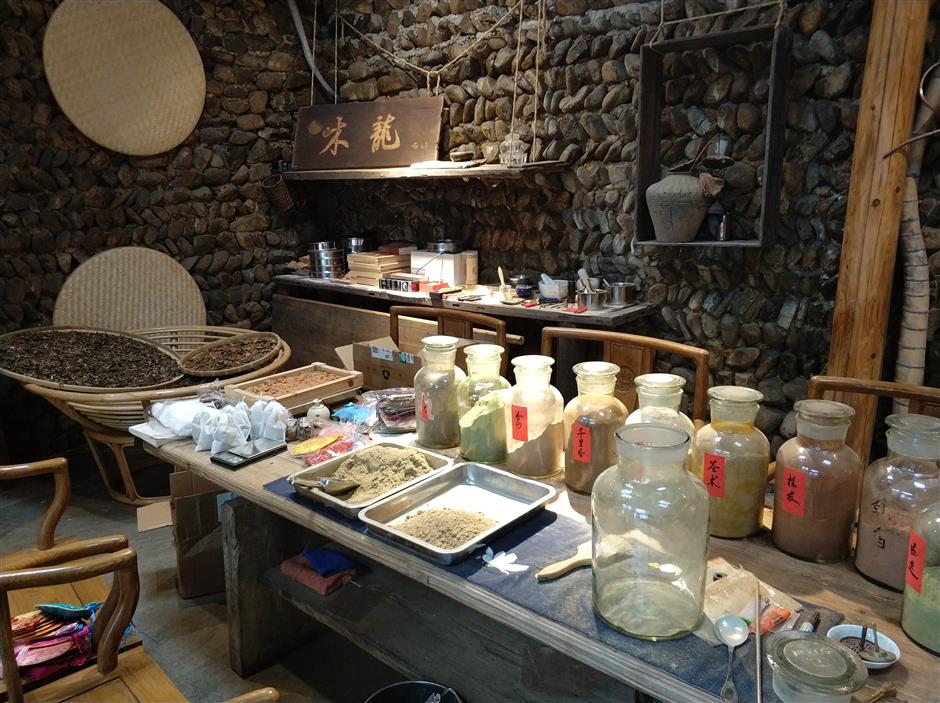Olfactory master spices up our daily lives
When Yan Senbiao — or Sunan, as most of his friends and clients call him — was studying illustration art in college, he worked part-time collating files for censers in a museum.
In the end, his job, not his studies, determined his career path. He became a traditional Chinese flavorist and aromatherapist.
Sunan, 30, now owns a workshop in the ancient Zhejiang Province village of Shen’ao, where he studies, does research and makes aromatic products.
His principal output is incense — not perfume, as people might assume — and everything is made by hand from scratch.
“For a long time, people assumed that incense burning was only for ceremonial activities on special occasions,” he said. “But that is actually not the case. Incense can be widely used in our daily lives, for enjoyment as well as healing the body and mind.”

Sunan in his workshop
After graduating from Jiangxi Normal University, some of Sunan’s friends introduced him to traditional Chinese flavorists in Taiwan. His communications with them further opened his eyes, showing him that aroma blending comes more from experience than from teaching.
There are thousands of different spices that can be made into incense, though only about 300 of them are frequently used. It is a long, difficult process to become familiar with all of them.
Herbs and spices growing in different places emit entirely different effects and have different prime harvesting times. To find the best materials, Sunan has suppliers in Taiwan, Indonesia and other Southeast Asian locales. He even explored the remote mountains on the border of Yunnan Province and Myanmar to look for the spices that can’t be found anywhere else.
“You have to spend time studying spices,” he said. “The better you know them — such as their aroma, quality grade and function — the better you can blend them.”
The key difference between traditional Chinese and Western blending is how the raw materials are used. Western flavorists usually extract the elements they need to create a product; the Chinese typically use the material as a whole.
“We call it the ‘all-molecule way,’” Sunan explained. “It requires a flavorist to know every element in a material and how each relate to the others.”
The process of making an incense stick requires patience. Carefully selected materials, usually herbs and spices, are ground into powders and the impurities sieved out.
The powders of different material are mixed together with water and pressed into pastes, which are shaped into sticks, then dried. After everything is done, Sunan burns a stick to test its aroma and see if it lives up to his expectations.

Sunan prepares ingredients for incense.
He is not merely a craftsman bringing fragrance to people’s lives. Sunan say he believes that the healing properties of aroma are equally important.
As a certificated aromatherapist with the US-based National Association for Holistic Aromatherapy, he tries to combine traditional Chinese medicine and aroma blending, with the aim of improving well-being.
“Many recipes recorded in ancient Chinese books are a good reference,” he said. “Just like traditional Chinese medicine, aromatherapy tries to use the power of nature to balance the body and the mind.”
One of Sunan’s best products is called “Across (亦渡),” which is made according to a recipe recorded in the “Compendium of Materia Medica,” a Chinese herbology volume written in the Ming Dynasty (1368-1644). Using 24 spices, including frankincense, fennel and clove, the incense creates a fruit-like sweet-and-sour aroma that’s said to cheer people up.
“Usually the smell of incense reminds people of solemn places, such as temples or ancient royal palaces,” he said. “But Across gives out an entirely different vibe — a brisk and joyous one.”
Another of his creations is called “Profound Silence (万籁静寂),” using agarwood, styrax, nard and figwort root as main ingredients. The clear, sweet aroma creates a tranquil atmosphere, helping people to achieve peace of mind.
“My customers tell me they use this incense as a sleep aid,” Sunan said. “They say it makes them feel as if they are back in their mother’s embrace.”
Before settling down in Shen’ao Village, Sunan spent four years traveling around the country looking for a site for his workshop. He chose a small, quiet village because big city environments are the enemies of a flavorist.
“The daily work of a flavorist is to smell and think,” Sunan said. “Bad air quality and a fast pace of life damage both.”

Sunan’s workshop in Shen’ao Village is a potpourri of intoxicating herbs and spices.
The 800-year-old village, which is 16.5 kilometers from the nearest town, satisfied Sunan’s every need. There is pure air and unpolluted spring water, and the surrounding hills are filled with plants that he can use in his recipes.
“When I first settled here, the village was barely known to outsiders,” he recalled. “The layout and buildings of the village are pretty much the way they looked in ancient times. Even as the village has started to welcome more visitors, the culture and atmosphere haven’t been compromised.”
And perhaps in tune with the past, Sunan has no online shop in the era of e-commerce.
His business runs on word-of-mouth, on happy repeat customers and on tourists who stop by his workshop.















